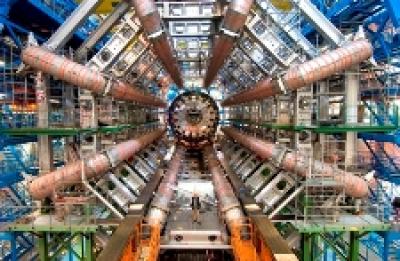In one week from today, the Large Hadron Collider(LHC) will take its first step 'back in time.' What is mass? What happened at the beginning of the universe? Are there other dimensions? We'll be on the way to finding out.
It's taken about 6,000 researchers, been over budget and behind schedule but it's finally ready to go.
If all goes according to plan, the superconducting magnets in the collider will zap atomic particles around the 17-mile tunnel at roughly the speed of light. Then the scientists will smash the particles together, replicating what happened mere nanoseconds after the first big bang.

Tel Aviv University School of Physics and Astronomy professor Erez Etzion participated in the design and construction of the trigger chambers for ATLAS, one of the two main detectors in the collider. This critical piece of machinery will decide what online data to record ― and what data to discard ― from the 1 billion atomic collisions per second. There is no storage disk space in the universe big enough to hold all the data, says Prof. Etzion, making this detector a key component in the success of the LHC.
Should We Change It To "May The 'Z*' Be With You?"
Prof. Etzion will be watching closely to see what happens to proton beams colliding at super speeds. While invisible particles are expected to leave a trace like a watermark after they collide, he believes that some particles will escape detection, possibly travelling to other dimensions.
This is an exotic theory, Prof. Etzion admits, but one which may explain why the force of gravity appears to be so weak. "It could be that while all the matter we know is trapped in three space dimensions, a gravity carrier can move into additional dimensions, resulting in a diluted gravitational force", he says, noting he and his colleagues will be looking for particles delivered by a force carrier called the "Z*" or "zee star." The physicists hypothesize that the Z* may be able to move between our own three-dimensional world and other hidden dimensions.
The notion of new dimensions is stranger than science fiction, though the possibility of their existence is quite real. Prof. Etzion believes that other dimensions may exist in parallel to ours, but that ― until now ― they were too small for us to experimentally detect. "For the first time we will reach a new energy scale in our lab, the Tera electron volt regime, and we expect to discover new phenomena there," he says. "At such high energies, we may be able to stimulate particles to jump through dimensions and can measure this by the disappearance of mass or energy, or the appearance of new excited state towers of particles."
Hanging by a Vibrating String
Prof. Etzion's research falls within a branch of theoretical physics known as string theory. The theory posits that all matter is made up of vibrating strings of energy, suggesting six or more dimensions we cannot see affect everything we do and see. It is an appealing model to physicists, since it offers mathematical solutions to the major unanswered questions in particle physics.
This September, physicists around the world will be on the edges of their seats to see what happens when the first beam is circulated through the collider. The first high-energy collisions are expected to take place in October 2008.





Comments